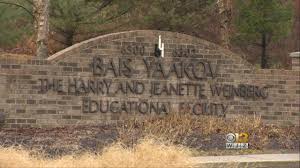
In 2021, we take it for granted that we have day schools for our children to attend. We are hardly surprised when we hear that Bais Yaakov has six or seven parallel classes in each grade. It was not always like that. When I attended Bais Yaakov (I graduated in 1973) there was only one class per grade, and my class had about 17 girls. But, although the school was much smaller, I also took it for granted that I was entitled to attend a Jewish school and get a Torah education.
What was it like for the pioneers, though,
when Jewish education for girls was a novelty? The idea for this article came
from Mrs. Chava Rosenfeld, the daughter of Rabbi Tzvi Elimelech Hertzberg, zt”l, the first rabbi of Congregation
Beth Abraham, affectionately known to this day as Hertzberg’s. He was one of
the original signers on the charter that established Bais Yaakov of Baltimore. Mrs.
Rosenfeld remembers the excitement of the beginning years.
“My father was quite active in establishing Bais Yaakov,” says Mrs.
Rosenfeld, “working with other rabbanim
of the time. Together, they recruited others to help establish the
school. Many people at the time felt that this type of school was not
needed as the public schools were quite good. Baruch Hashem, these
dedicated people persevered, and the school was established.”
Many people at that time also did not
believe that girl’s education was necessary. I read a story in a book written
by Rabbi Myer Schwab about his father, Rabbi Shimon Schwab (Rabbi Schwab on Chumash, p. 242) that
sheds light on the ideas of that time:
During the 1940s, before there was a Bais Yaakov high school
in Baltimore, Rav Schwab organized weekly Torah classes for high-school-age
girls to supplement their chinuch with strong Torah messages. Young ladies, including the
Rav’s own daughter, were forced to attend public schools, and the Rav’s classes
were the only dose of Torah these girls had.
When other Rabbanim heard of this development, some of them
approached the Rav saying, “Why are you always involving yourself with trivial
and insignificant mitzvos? It’s beneath the Rav’s dignity to teach girls; it
doesn’t befit the stature of a talmid chacham to engage in such activities.”
The Rav answered, “I am sure you have heard the Gemara’s
definition of a chasid
shoteh (a pious fool). The Gemara discusses a situation in which a ‘pious’
man walking along a river bank hears a drowning person screaming for help. As
the man is prepared to jump in, he notices that the person is a woman, and he
withdraws, saying that to save her would entail a breach of tznius. The
Talmud calls this person a chasid shoteh, a foolish chasid.”
The Rav extrapolated, “Don’t you see that these girls are
drowning? Without Torah they will be swallowed up by the values of the street
and lost to the Torah world. I refuse to be a chasid shoteh. I
choose the mitzvah of hatzalas nefashos.”
In
1941, a charter was granted by the State of Maryland to establish the Beth
Jacob Hebrew Parochial School for Girls of Baltimore. Later the name was
changed to Bais Yaakov School for Girls. Some of the people who signed the
charter were Rabbi A.E. Axelrod, Rabbi E. Davis, Rabbi H. Hertzberg, Ichel
Folick, Joseph Fax, and Moshe Flom. According to Mrs. Rosenfeld, signing
the charter meant taking financial responsibility for the new school.
The school opened
its doors for its first class in 1942 in the Anshe Emes Shul on Linden Street.
By the following year, it had outgrown the first classroom and moved to another
shul on Brookfield Avenue.
I had the privilege of speaking to Mrs. Rhoda
Steinberg Pollak of Lakewood, who was a member of that first class together
with her twin sister Barbara; they were joined the following year by their
younger sister Bernice.
Mrs. Pollak was born in New York and
moved to Baltimore when she was five years old. She started going to Bais Yaakov in second grade.
She later married Rabbi Binyomin Steinberg, zt”l,
who was the principal of Bais Yaakov High School for over 30 years. At my
request she told me some of her memories.
The first two students of Bais Yaakov were Rosalie Taragin
(now Zalis) and Bettie Rose Cohen (now Mandelbaum); Mrs. Pollak, then known as
Rhoda Stauber and her sisters joined the school a couple of weeks later.
“We loved going to Bais Yaakov,” Mrs. Pollak said. “It
was much better than public school.” Every year they added a grade until eighth grade. Their
teacher, Mrs. Liesel Hess, the mother of Chaya Sher, was hired by Rabbi Shimon
Schwab because he thought she had the proper hashkafos to
teach girls. Mrs. Sher said her mother told her that the motto of Bais Yaakov was, “Educate a boy
and you educate an individual; educate a girl and you educate a
family.”
The school was far from the homes of most of
the girls, so Mrs. Pauline Davidavitz, the devoted president of the Ladies
Auxiliary, picked up the Stauber girls in a taxi every morning. Mrs. Davidavitz
did not have any children of her own but dedicated herself to the education of
Jewish girls.
Mrs. Pollak also told me a funny story. Rabbi
Igla was a devoted and talented teacher who taught the girls limudei kodesh. Because English
was not his native tongue, he used an English translation to teach Chumash to
the girls, with some interesting results. In the parsha of the akeida, when Avraham told his servants to
wait for him while he and Yitzchak went on to the mountain, Rabbi Igla read the
translation, which was “Abide you here with the donkey.” When a girl was asked
what that phrase meant, she said, “Don’t you know what ‘bite your ear’ means?”
The fledgling school did not go beyond eighth grade,
and the students would attend public high school. I asked Mrs. Pollak about
Western High School, an all-girls school, which she attended and whether it was
uncomfortable for them as frum girls attending a secular
school.
“It was a great school with high level
academics, and we were treated well most of the time. For example, if a test
was given on Yom Tov, we were allowed to postpone it for another day. Every morning
we started the day with reading from the Bible. The teacher would choose
specific girls to read a chapter in the Bible each day. She often gave us the
Bible to read, and it was opened to the New Testament, but we always flipped
back to the Old Testament and read from the Psalms. The teacher accepted our
chosen chapters, and there were no further discussions about this.
One time, however, Mrs. Pollak’s sister won a
citywide essay contest on the topic, “What Democracy Means to Me.” She was
entitled to go on to the statewide competition, which took place on a Friday
night. Western High School’s principal was quite upset that the school would
not be able to be part of the contest because their winning contestant would
not attend. She berated Barbara Stauber (now Rebbetzin Shapiro of Miami) for
following archaic rules and suggested that moving to Israel might be something
to consider!
After the day at public high school, the
girls went back to Bais Yaakov for
limudei kodesh studies under the
leadership of Rabbi Hirsch Diskind, Bais Yaakov’s longtime dean. Mrs. Pollak
said that she enjoyed going and did not mind the long days and extra studies.
“We were Bais Yaakov girls
at heart,” she says. After graduating with honors from Western High School,
Mrs. Pollak, her twin sister, and some of the other students attended Bais
Yaakov Seminary in Williamsburg.
Mrs. Pollak and her early classmates
credit their love of Yiddishkeit to all that Bais Yaakov of Baltimore gave
them. Mrs. Pollak is grateful to Bais Yaakov, its founders, and especially her
parents for the opportunity to attend a Bais Yaakov.






